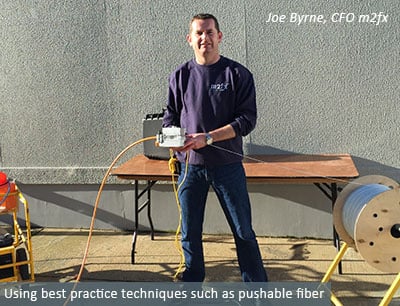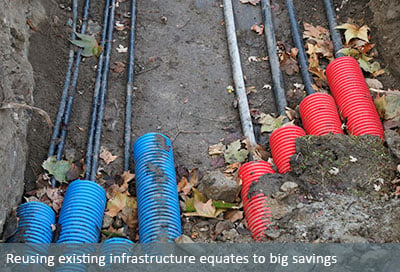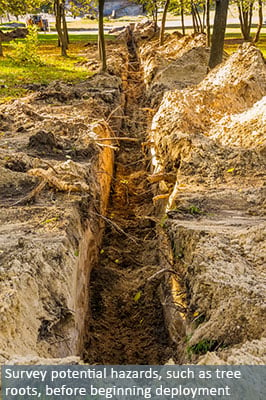 Last year, I published a blog post on the steps you can take to reduce FTTX roll out costs, aiming to help spread best practice amongst the fiber community. I invited feedback and suggestions from those in the field on other important steps that might also reduce implementation costs. In this post, I consider some of the points that people kindly shared with me – thanks again to everyone for their comments.
Last year, I published a blog post on the steps you can take to reduce FTTX roll out costs, aiming to help spread best practice amongst the fiber community. I invited feedback and suggestions from those in the field on other important steps that might also reduce implementation costs. In this post, I consider some of the points that people kindly shared with me – thanks again to everyone for their comments.
To recap, the 5 steps outlined in my original post were:
- Take time and research your options. Learn from your peers and ensure you are up to date with the latest thinking and best practice.
- Develop a solid plan for people, equipment and finance.
- Ensure you run a well thought out procurement process.
- Validate your plan with back-to-back trials of different deployment options.
- Have strength in your convictions and follow through.
Let’s now consider 5 additional steps, based on some of the feedback I received:
1. Reuse existing duct infrastructure
 Over 50% of the cost of a typical FTTH network roll out is down to civil works, such as trenching. Therefore, anything you can do to avoid the need to dig trenches will save you money, and that means reusing existing ducts. In a brownfield environment, there are very often ducts available from the incumbent operator, utilities or municipalities.
Over 50% of the cost of a typical FTTH network roll out is down to civil works, such as trenching. Therefore, anything you can do to avoid the need to dig trenches will save you money, and that means reusing existing ducts. In a brownfield environment, there are very often ducts available from the incumbent operator, utilities or municipalities.
In countries where operators have built an extended duct infrastructure, over the last few decades, dramatic cost savings can be achieved by installing new cables on top of the existing utility and communication cables/conduits. For example, in France and Spain several operators have deployed their FTTX network using the ducts of the incumbent, saving billions of Euros on installation costs.
2. Use good design and documentation software with quality control
This is not only important during the initial build, but also for operations and network evolution - just think, for example, about the workflow of adding further ONTs (Optical Network Terminals) to your deployment. Often documenting your design is something which is conveniently forgotten.
Also, when handing out duct installation contracts be sure to clearly define your deployment parameters and requirements. Digging a trench and laying ducts may sound basic, but it still requires quality control as not all contractors are equally reliable. If you want to reuse your expensive infrastructure again then invest a few more dollars to have it done right first time, rather than having to spend a lot more later on.
3. Do impact studies on the actual deployment area
 Take the time to survey in detail where you are installing your network. Factors - such as utility right of ways, buried utility densities, aerial routing legalities, geological soil and root systems and facilities locations - can all dramatically impact complexity, time and cost. You can save all the money in the world on materials and tooling but an unexpected mile of tree roots can completely blow your deployment budget.
Take the time to survey in detail where you are installing your network. Factors - such as utility right of ways, buried utility densities, aerial routing legalities, geological soil and root systems and facilities locations - can all dramatically impact complexity, time and cost. You can save all the money in the world on materials and tooling but an unexpected mile of tree roots can completely blow your deployment budget.
4. Co-ordinate and automate roll out processes and project resources
It’s a daily operational challenge, to ensure that no workers are standing idle and all on-site visits are efficient, particularly as planning is constantly obstructed by unforeseen events. Help get a better handle on what is happening by integrating the project team and subcontractor field resources into a single common information system. This means that all information resides in one place, with individual users having access only to the areas that are appropriate to their role. By allowing everyone involved to update a single system directly in the field, relevant people are notified about the events that matter to them, and can quickly get hold of the right information they need for the deployment. It also provides accurate, timely information to the central roll out team. This translates into better daily decision-making, leading to cost savings and increased customer satisfaction.
5. Maximize the end market as early as possible
Ultimately there's a customer that's going to pay for the FTTH implementation by subscribing to an operator’s services. And the more subscribers you can get in a street, the greater the return on your deployment investment. So, make sure when trenching in paved streets to have ducts made up to every building’s property line, even to those that have initially declined the service. In that way, you’ll have a very affordable way of adding new subscribers if, and when, they change their mind.
Since penetration rates are the key factor when costing a project it's important to have a strong sales pitch. For example, have a time-limited offer sent out, and send sales teams to visit every property owner. Be clear in your marketing about the price for future connections compared to now, and ensure that it is a lot higher than your present price. For every subscriber, put up a sign on their property, just like a real estate agent’s, facing the street with a message like "I've ordered 1000 Mbps broadband from Company X." Advertising like this will help drive more sales – after all, when people see that their neighbor has signed up, they may well follow. The sign also serves a practical purpose, showing where the fiber will be trenched.
In summary, planning, using best practice and smart implementation methods will continue to drive down the cost of FTTX roll outs. We’re repeating a maturity cycle that has been seen many times in other technologies. Sharing knowledge and best practice will help speed the adoption of FTTX and benefit the whole fiber community by expanding the total market and bringing down costs. So feel free to add more best practice suggestions in the comments section below – if I get enough I’ll put together another blog on the subject.



Comments